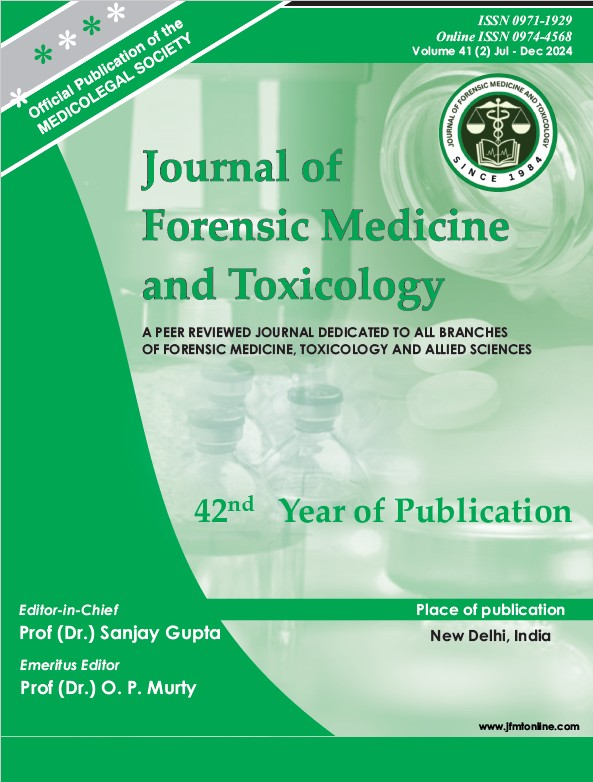Unveiling Invisible Clues: The Evolving Landscape of Clinical Microbiology in Forensic and Toxicological Studies
DOI:
https://doi.org/10.48165/jfmt.2025.42.3.16Keywords:
Forensic Microbiology, Clinical Microbiology, Forensic Medicine, Artificial intelligence, EthicsAbstract
The integration of clinical microbiology into forensic medicine and toxicology has revolutionized investigative method ologies, enhancing the precision of criminal investigations. This review examines the role and impact of clinical micro biology in forensic contexts, focusing on its applications, technological advancements, challenges, ethical considerations, and future prospects. Forensic microbiology has proven invaluable in various forensic investigations, such as identifying pathogens in unex pected deaths, analysing soil microbiomes to infer crime scene geolocations, and utilizing the human microbiome for individual identification. Advances in next-generation sequencing, artificial intelligence, and machine learning have significantly enhanced the capabilities of forensic microbiology, enabling faster and more precise analyses. These tech nologies facilitate a deeper understanding of microbial evidence, contributing to more accurate forensic conclusions. However, the field faces challenges, including the need for standardized methodologies and protocols, rapid pathogen identification, and handling complex microbial ecosystems. Ethical considerations, particularly regarding the privacy of microbiome data and its legal interpretation, are also pivotal. Future research directions emphasize developing rapid on-site testing methods, expanding microbial databases, and establishing robust ethical frameworks for microbiology’s use in forensic science. These advancements are anticipated to further refine forensic microbiological methods, ensuring their responsible and effective application in legal investiga tions. In summary, the integration of clinical microbiology into forensic medicine and toxicology marks a significant ad vancement in forensic science. It offers enhanced capabilities in crime scene analysis and pathogen identification, while posing challenges that require careful consideration and ongoing research. The continued evolution of this field prom ises to significantly contribute to the efficacy and integrity of forensic investigations.
Downloads
References
Tambuzzi S, Maciocco F, Gentile G, Boracchi M, Faraone C, Andreola S, et al. Utility and diagnostic value of postmortem microbiology associated with histology for forensic purposes. Forensic Sci Int [Internet]. 2023 Jan 1 [cited 2023 Dec 22];342:111534. Available from: https://www.sciencedirect.com/science/article/pii/S0379073822003644
Oliveira M, Amorim A. Microbial forensics: new breakthroughs and future prospects. Appl Microbiol Biotechnol [Internet]. 2018 [cited 2023 Dec 22];102(24):10377–10391. Available from: https://www.ncbi.nlm.nih.gov/pmc/articles/PMC7080133/
Schmedes S, Budowle B. Microbial Forensics. Encyclopedia of Microbiology [Internet]. 2019 [cited 2023 Dec 22];134145. Available from: https://www.ncbi.nlm.nih.gov/pmc/articles/PMC7149751/
Robinson JM, Pasternak Z, Mason CE, Elhaik E. Forensic Applications of Microbiomics: A Review. Front Microbiol [Internet]. 2021 Jan 13 [cited 2023 Dec 22];11:608101. Available from: https://www.ncbi.nlm.nih.gov/pmc/articles/PMC7838326/
Metcalf JL, Xu ZZ, Bouslimani A, Dorrestein P, Carter DO, Knight R. Microbiome Tools for Forensic Science. Trends Biotechnol. 2017 Sep;35(9):814–823.
HISTORIC SARANAC LAKE [Internet]. [cited 2023 Dec 22]. Saranac Laboratory. Available from: https://www.historicsaranaclake.org/saranac-laboratory.html
Yee K. Research Guides: Center for the History of Microbiology/ASM Archives (CHOMA): Milestones in Microbiology [Internet]. [cited 2023 Dec 22]. Available from: https://lib.guides.umbc.edu/c.php?g=836720&p=6543681
Yuan H, Wang Z, Wang Z, Zhang F, Guan D, Zhao R. Trends in forensic microbiology: From classical methods to deep learning. Front Microbiol [Internet]. 2023 [cited 2023 Dec 22];14. Available from: https://www.frontiersin.org/articles/10.3389/fmicb.2023.1163741
Cho HW, Eom YB. Forensic Analysis of Human Microbiome in Skin and Body Fluids Based on Geographic Location. Front Cell Infect Microbiol [Internet]. 2021 Aug 12 [cited 2023 Dec 22];11:695191. Available from: https://www.ncbi.nlm.nih.gov/pmc/articles/PMC8388931/
Wang Z, Zhang F, Wang L, Yuan H, Guan D, Zhao R. Advances in artificial intelligence-based microbiome for PMI estimation. Front Microbiol [Internet]. 2022 [cited 2023 Dec 22];13. Available from: https://www.frontiersin.org/articles/10.3389/fmicb.2022.1034051
Sharma R, Diksha, Bhute AR, Bastia BK. Application of artificial intelligence and machine learning technology for the prediction of postmortem interval: A systematic review of preclinical and clinical studies. Forensic Sci Int [Internet]. 2022 Nov 1 [cited 2023 Dec 22];340:111473. Available from: https://www.sciencedirect.com/science/article/pii/S0379073822003036
Koontz JM, Dancy BCR, Horton CL, Stallings JD, DiVito VT, Lewis JA. The Role of the Human Microbiome in Chemical Toxicity. Int J Toxicol. 2019;38(4):251–264.
Handy RD, Clark NJ, Hutt LP, Bescós R. The microbiomes of wildlife and chemical pollution: Status, knowledge gaps and challenges. Curr Opin Toxicol [Internet]. 2023 Dec 1 [cited 2023 Dec 22];36:100428. Available from: https://www.sciencedirect.com/science/article/pii/S2468202023000438
The Forensic Microbiome: The Invisible Traces We Leave Behind | National Institute of Justice [Internet]. [cited 2023 Dec 23]. Available from: https://nij.ojp.gov/topics/articles/forensic-microbiome-invisible-traces-we-leave-behind
Human Microbiome Project | NIH Common Fund [Internet]. [cited 2023 Dec 23]. Available from:https://commonfund.nih.gov/hmp
Space Station Research Explorer on NASA.gov [Internet]. [cited 2023 Dec 23].




